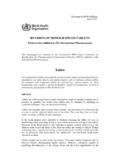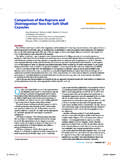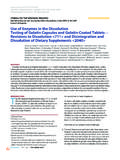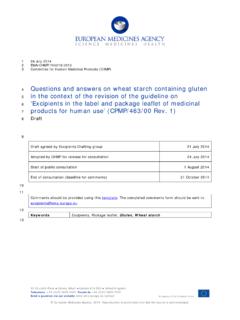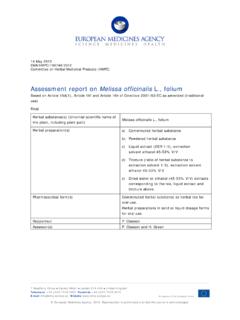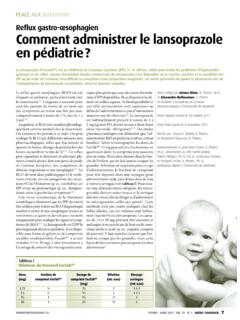Transcription of REVISION OF MONOGRAPH ON CAPSULES - WHO …
1 Document March 2011. REVISION OF MONOGRAPH ON CAPSULES . Final text for addition to The International Pharmacopoeia This MONOGRAPH was adopted by the Forty-fourth WHO Expert Committee on Specifications for Pharmaceutical Preparations in October 2009 for addition to The International Pharmacopoeia. CAPSULES The requirements of this MONOGRAPH do not necessarily apply to preparations that are intended for use other than by oral administration, such as vaginal or rectal CAPSULES etc. Such preparations may require a special formulation, method of manufacture, or form of presentation, appropriate to their particular use. Starch CAPSULES (often known as cachets).
2 Are not included in this MONOGRAPH . Definition CAPSULES are solid dosage forms with hard or soft shells. They are of various shapes and sizes, and contain a single dose of one or more active ingredients. They are intended for oral administration. capsule surfaces may bear symbols or other markings. capsule shells are made of gelatin or other substances, the consistency of which may be modified by the addition of substances such as glycerol or sorbitol. The shell should disintegrate in the presence of digestive fluids so that the contents are released. The contents of CAPSULES may be solid, liquid, or of a paste-like consistency.
3 capsule shells and contents may contain excipients such as diluents, solvents, surface-active substances, opaque fillers, antimicrobial agents, sweeteners, colouring matter authorized by the appropriate national or regional authority, flavouring substances, disintegrating agents, glidants, lubricants, and substances capable of modifying the behaviour of the active ingredient(s) in the gastrointestinal tract. The contents should not cause deterioration of the shell. Document page 2. When excipients are used, it is necessary to ensure that they do not adversely affect the stability, dissolution rate, bioavailability, safety, or efficacy of the active ingredient(s).
4 There must be no incompatibility between any of the components of the dosage form. The different categories of capsule include: hard CAPSULES ;. soft CAPSULES ; and modified-release CAPSULES [including delayed-release CAPSULES (gastro- resistant/enteric CAPSULES ) and sustained-release CAPSULES (extended-/prolonged- release CAPSULES )]. Manufacture The manufacturing and filling processes for CAPSULES should meet the requirements of good manufacturing practices (GMP). Very broad guidelines concerning the main critical steps to be followed during production of CAPSULES , indicating those that are the most important, are provided below.
5 Additional guidelines specific for hard or soft CAPSULES are provided in the respective subsections below. In the manufacture of CAPSULES , measures are taken to: ensure that the active ingredient(s) when present in solid state form have appropriate solid-state properties such as particle-size distribution and polymorphic form;. ensure that mixing with excipients is carried out in a manner that ensures homogeneity;. minimize the degradation of the active ingredient(s);. minimize the risk of microbial contamination; and minimize the risk of cross contamination. The particle size of the active ingredient(s) may be of primary significance in determining the rate and extent of dissolution and the bioavailability of the drug product, especially for substances of low solubility in aqueous media.
6 The uniformity of the final drug product is affected by the particle size of the active ingredient(s) as well as the excipients. Throughout manufacturing, certain procedures should be validated and monitored by carrying out appropriate in-process controls. These should be designed to guarantee the effectiveness of each stage of production. Packaging is required to be adequate to protect CAPSULES from light when required, and from moisture and damage during transportation. Document FINAL. page 3. Visual inspection Unpack and inspect at least 20 CAPSULES . They should be smooth and undamaged. Evidence of physical instability is demonstrated by gross changes in physical appearance, including hardening or softening, cracking, swelling, mottling, or discoloration of the shell.
7 Uniformity of mass CAPSULES comply with the test for Uniformity of mass for single-dose preparations, unless otherwise specified in the individual MONOGRAPH . Uniformity of content Where a requirement for compliance with the test for Uniformity of content for single-dose preparations is specified in an individual capsule MONOGRAPH the test for Uniformity of mass for single-dose preparations is not required. Dissolution/disintegration Where a choice of test is given ( Either test A or test B may be applied ), follow the instructions in the MONOGRAPH . Where a requirement for compliance with a dissolution test is specified in the individual MONOGRAPH , the requirement for disintegration stated in the sections below do not apply.
8 Labelling Every pharmaceutical preparation must comply with the labelling requirements established under GMP. The label should include: (1) the name of the pharmaceutical product;. (2) the name(s) of the active ingredient(s); International Nonproprietary Names (INNs) should be used wherever possible;. (3) the amount of the active ingredient(s) in each capsule and the number of CAPSULES in the container;. (4) the batch (lot) number assigned by the manufacturer;. (5) the expiry date and, when required, the date of manufacture;. (6) any special storage conditions or handling precautions that may be necessary;. (7) directions for use, warnings, and precautions that may be necessary; and (8) the name and address of the manufacturer or the person responsible for placing the product on the market.
9 Document page 4. Storage CAPSULES should be kept in well-closed containers. They should be protected from light when required, and from excessive moisture, or dryness, and should not be subjected to temperatures above 30 C. Additional special packaging, storage, and transportation recommendations are provided, where necessary, in the individual MONOGRAPH . Requirements for specific types of CAPSULES Hard CAPSULES Definition Hard CAPSULES have shells consisting of two prefabricated cylindrical sections that fit together. One end of each section is rounded and closed, and the other is open. The contents of hard CAPSULES are usually in solid form (powder or granules).
10 Manufacture Sometimes, the physical characteristics of the mixture of the active ingredient(s) and excipients allow it to be directly filled into the shell, but it may occasionally be necessary to granulate before filling. Normally the granulate needs to be mixed with lubricants and/or disintegrating agents. The use of excessive amounts of lubricants should be avoided since these may deleteriously affect the CAPSULES . In-process controls during hard capsule production should include the moisture content of the mixture and/or granulate (as well as of the shells), the size of granules, the flow of the final mixture, and the uniformity of mass, capsule size, integrity of the seals, and disintegration or dissolution rate ( for modified-release CAPSULES ) of the finished dosage form.










